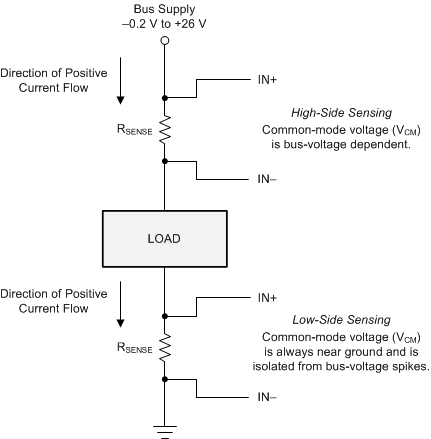SLYS017D April 2018 – July 2022 INA180-Q1 , INA2180-Q1 , INA4180-Q1
PRODMIX
- 1 Features
- 2 Applications
- 3 Description
- 4 Revision History
- 5 Device Comparison
- 6 Pin Configuration and Functions
- 7 Specifications
- 8 Detailed Description
- 9 Application and Implementation
- 10Device and Documentation Support
Package Options
Mechanical Data (Package|Pins)
- DBV|5
Thermal pad, mechanical data (Package|Pins)
Orderable Information
8.3.2 Wide Input Common-Mode Voltage Range
The INAx180-Q1 support input common-mode voltages from –0.2 V to +26 V. Because of the internal topology, the common-mode range is not restricted by the power-supply voltage (VS) as long as VS stays within the operational range of 2.7 V to 5.5 V. The ability to operate with common-mode voltages greater or less than VS allow the INAx180-Q1 to be used in high-side, as well as low-side, current-sensing applications, as shown in Figure 8-4.
 Figure 8-4 High-Side and Low-Side Sensing Connections
Figure 8-4 High-Side and Low-Side Sensing Connections